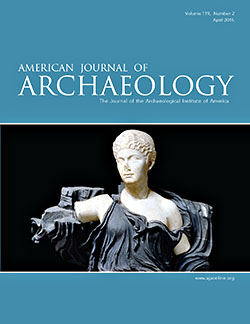AJA Open Access
BY-NCApril 2015 (119.2)
Book Review
Corpus vasorum antiquorum. Germany 93. Berlin 13: Attisch rotfigurige Lekythen
By Nina Zimmerman-Elseify
Reviewed by Jenifer Neils
When it comes to the common Attic vase shape known as the lekythos, scholars have fixated on those produced in the special technique of white ground, the imagery of which is largely funerary and whose distribution was mostly limited to Attica. Thus, red-figure lekythoi have not received the attention they deserve for their more varied iconography, their wider distribution in the Mediterranean, and their role in Greek daily life. This latest CVA from the Antikensammlung in Berlin, which publishes 58 red-figure shoulder lekythoi, helps to augment and amplify what has been lacking in studies of this popular shape.
The introduction provides a thorough overview of the Attic shoulder lekythos, a shape that comes on the scene ca. 530 B.C.E. in black-figure and is quickly taken up by red-figure painters. The shape flourishes in the second quarter of the fifth century and tapers off ca. 420 B.C.E., thus enjoying a century of production. This comprehensive introduction traces the development of the shape, surveys the iconography from the mythological to the mundane, and analyzes its function in daily (as opposed to the after-) life.
To illustrate the complexity of these lekythoi, let us take one example (Berlin F 2211) attributed to the Painter of the Paris Gigantomachy (ca. 470 B.C.E.). The author provides detailed information and bibliography where relevant on the vase’s state of preservation, clay and slip, shape (including a 1:2 profile drawing), subsidiary ornament, figural decoration, inscriptions, preliminary sketch and relief line, and painter—as is the norm for most CVAs. This lekythos depicts Nike, a not uncommon subject on this type of vase, standing frontally and holding a scepter in one hand and an aphlaston (ship’s stern ornament, also known as an acroterion, of which there is a good detail on pl. 5) in the other. Next to her is a low platform-like altar with an apple resting on it, and the field is inscribed “he pais kale.” Representations of aphlasta are rare, there being only eight examples in Attic red-figure; they are held by Athena (four examples), Nike (two examples), and Poseidon (two examples). Because these examples all fall within the decades 480–460 B.C.E., they are usually said to reference the Athenians’ naval victories at Salamis or the Eurymedon. Another suggestion (mine) is that the vases might be victory souvenirs in an agon at the Panathenaia, namely the newly instituted tribal regatta. Delving deeper, the mysterious apple, also somewhat of a rarity on altars (four examples cited by the author), may provide a clue to the precise meaning of the scene. Both Theophrastus (4.4.2) and Pliny the Elder (12.15) refer to a type of citron as the “Persian” or “Median” apple. If that is what is depicted here, then the Persian reference is undoubtedly the correct one.
Given the tall, narrow shape of the shoulder lekythos, two-figure compositions are common. Mythological examples in Berlin include abductions (Paris and Helen, Eos and Tithonos twice), a rare rescue from the Underworld (Herakles and Theseus or Peirithoos because of the beard?), and an unusual birth (Helen from the egg). Single divine figures include Dionysos, Hermes, Eros, Nike, and Leto holding the baby Apollo with his bow directed at an absent monster (demonstrating that this was a childhood feat and thus invalidating the recent hypothesis that the new bronze Apollo Sauroktonos in Cleveland represents Apollo killing the Python [www.clevelandart.org/art/2004.30.a]). Domestic scenes include a woman at the fountain house and an unusual one showing a child in a high chair or potty seat, attended by a nurse or his mother.
The lekythoi from the second half of the century are duller in subject matter and scruffier in style: numerous fluttering Nikai, flying Erotes, women and youths making offerings at altars, a large female head, and an owl. An exception is the fine “mistress and maid” lekythos painted by a close associate of the Achilles Painter. There are only two red-figure lekythoi with obvious funerary iconography: one, sadly lost in World War II, shows a mournful woman seated before a grave stele, and the second depicts a draped youth in a similar position. Appropriately, the latter vase includes a depiction of a shoulder lekythos with Nike hanging in the background—perhaps a sales pitch for the potter?
Most of these vases were published by Furtwängler already in 1885 (Beschreibung der Vasensammlung im Antiquarium [Berlin]) and so are not unknown. However, this new CVA from Berlin shows them off in full color with details and profile drawings, and thereby helps to rescue Attic red-figure lekythoi from undue neglect.
Jenifer Neils
Department of Classics
Case Western Reserve University
jxn4@case.edu
